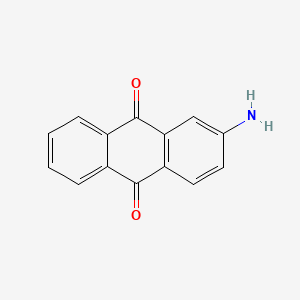Compound
D0665 | 2-aminoanthraquinone
| Toxicity | Dose | Time | Species | Model | Method | Action | Positive criterion | Reference |
|---|---|---|---|---|---|---|---|---|
| MEMBRANE POTENTIAL | 0.51±0.29 | human | qHTS-HepG2 | MMP assay | decrease | IC50 | 163 | |
| MEMBRANE POTENTIAL | 1.26 | human | HepG2 | MMP assay | decrease | IC50 | 163 | |
| MEMBRANE POTENTIAL | 3.57±2.61 | rat | hepatocytes | MMP assay | decrease | IC50 | 163 | |
| Pictogram | Signal | Statements | Precautionary Statement Codes |
|---|---|---|---|
 |
Warning |
Aggregated GHS information provided by 47 companies from 5 notifications to the ECHA C&L Inventory. Reported as not meeting GHS hazard criteria by 3 of 47 companies. For more detailed information, please visit ECHA C&L website Of the 4 notification(s) provided by 44 of 47 companies with hazard statement code(s): H351 (97.73%): Suspected of causing cancer [Warning Carcinogenicity] Information may vary between notifications depending on impurities, additives, and other factors. The percentage value in parenthesis indicates the notified classification ratio from companies that provide hazard codes. Only hazard codes with percentage values above 10% are shown. |
P201, P202, P281, P308+P313, P405, and P501; (The corresponding statement to each P-code can be found at the GHS Classification page.) |
| Organism | Test type | Route | Dose (normalized dose) | Effect | Source |
|---|---|---|---|---|---|
| rat | LD50 | intraperitoneal | 1500mg/kg (1500mg/kg) | Gigiena Truda i Professional'nye Zabolevaniya. Labor Hygiene and Occupational Diseases. Vol. 21(12), Pg. 27, 1977. | |
| .beta.-Aminoanthraquinone | .beta.-Anthraquinonylamine | 117-79-3 |
| 2-AAQ | 2-AMINOANTHRAQUINONE | 2-Amino-9,10-anthracenedione |
| 2-Amino-9,10-anthraquinone | 2-Amino-anthraquinone | 2-Aminoanthra-9,10-quinone |
| 2-Aminoanthra-9,10-quinone # | 2-Aminoanthraquinone, technical grade | 2-Aminoanthraquinone, technical, 85-90% (HPLC) |
| 2-Aminoquinone | 2-amino anthraquinone | 2-amino-9,10-dihydroanthracene-9,10-dione |
| 2-aminoanthracene-9,10-dione | 65Z03V2Z09 | 9, 2-amino- |
| 9,10-Anthracenedione, 2-amino- | A0255 | AAQ |
| AC-10747 | ACMC-1BO48 | AI3-09063 |
| AKOS000119069 | AM20020256 | ANW-17045 |
| AO-801/41077416 | Aminoanthraquinone (Related) | Anthraquinone, 2-amino- |
| BBL008612 | BIDD:ER0316 | BIM-0011444.P001 |
| C14444 | CAS-117-79-3 | CB14717 |
| CBMicro_011266 | CCRIS 23 | CHEBI:34258 |
| CHEMBL84685 | CTK3J2535 | DSSTox_CID_68 |
| DSSTox_GSID_20068 | DSSTox_RID_75345 | DTXSID6020068 |
| EINECS 204-208-4 | F1908-0138 | FT-0611225 |
| HMS3034D13 | HSDB 4088 | InChI=1/C14H9NO2/c15-8-5-6-11-12(7-8)14(17)10-4-2-1-3-9(10)13(11)16/h1-7H,15H; |
| KS-00000W6Q | KSC492K3L | LS-591 |
| MCULE-1564113866 | MFCD00001233 | MLS002152869 |
| NCGC00091610-01 | NCGC00091610-02 | NCGC00091610-03 |
| NCGC00091610-04 | NCGC00091610-05 | NCGC00253972-01 |
| NCGC00259071-01 | NCI-C01876 | NSC 5 |
| NSC-5 | NSC5 | Q27115949 |
| RTR-031326 | SBB000619 | SCHEMBL40960 |
| SMR000765637 | SMSF0003869 | ST2416449 |
| ST45245356 | STK396687 | T7331 |
| TR-031326 | TRA0097366 | Tox21_201521 |
| Tox21_300101 | U252 | UNII-65Z03V2Z09 |
| UNII-U3XG95BNI4 component XOGPDSATLSAZEK-UHFFFAOYSA-N | W-108558 | WLN: L C666 BV IVJ EZ |
| XOGPDSATLSAZEK-UHFFFAOYSA-N | ZINC3874029 | beta-Aminoanthraquinone |
| beta-Anthraquinonylamine |

